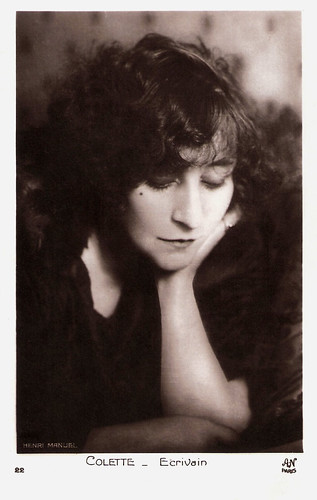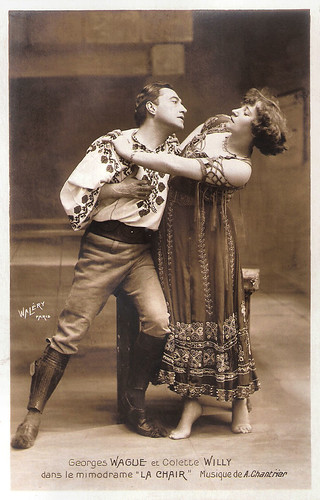One of our favourite authors is Sidonie-Gabrielle Colette (1873-1954) or simply Colette. The French novelist, journalist and performer is now best known for her sexy, courageous novels Chéri and Gigi, which were adapted into classic films. But many other films were based on her work; or she wrote dialogues for them. Today 12 dazzling postcards of Colette and of the stars of the films based on her novels.
![Colette]()
French postcard by A.N. Paris, no. 22. Photo: Henri Manuel.
![Georges Wague and Colette Willy in La Chair (1907)]()
As Colette Willy with Georges Wague in La Chair (1907). French postcard. Photo: Waléry, Paris. Publicity still for the mime drama La Chair/The Flesh (1907) written by Georges Wague and Leon Lambert, with music by Albert Chantrier. It was Colette's greatest stage success.
Sidonie-Gabrielle Colette was born in 1873, to war hero and tax collector Jules-Joseph Colette and his wife Adèle Eugénie Sidonie (Sido), nėe Landoy, in the French village of Saint-Sauveur-en-Puisaye. The family was initially well off, but by the time she was of school age poor financial management had substantially reduced her father's income and she attended a public school from the ages of 6 to 17.
In 1893, at age 20, Colette married Henry Gauthier-Villars He was a famous writer, music critic known as 'Willy'. He was 15 years her senior and described as a "literary charlatan and degenerate". He introduced Colette into avant-garde intellectual and artistic circles while engaging in sexual affairs and encouraging her own lesbian dalliances. Her first books, the titillating Claudine series, were published under her husband's pen name Willy.
The Claudine series contained the four novels Claudine à l'école/Claudine at school (1900), Claudine à Paris/Claudine in Paris (1901), Claudine en menage/Claudine Married (1902), and Claudine s'en va/Claudine and Annie (1903). They chart the coming of age of their heroine, Claudine, from an unconventional fifteen year old in a Burgundian village to the literary salons of turn-of-the-century Paris. The story they tell is semi-autobiographical, but not entirely — most strikingly, Claudine, unlike Colette, is motherless. Today, especially Claudine à l'école/Claudine at school (1900) still has the power to charm; in belle époque France it was downright shocking, much to Willy's satisfaction and profit.
Colette and Willy separated in 1906, although it was not until 1910 that the divorce became final. She had no access to the sizable earnings of the Claudine books — the copyright belonged to Willy. Colette went to work in the music halls of Paris, under the wing of Mathilde de Morny, Marquise de Belbeuf, known as 'Missy', with whom she became romantically involved. In 1907, the two performed together in Rêve d'Égypte, a pantomime at the Moulin Rouge. Their onstage kiss nearly caused a riot, which the police were called in to suppress. As a result of this scandal, further performances were banned, and Colette and de Morny were no longer able to live together openly, though their relationship continued for five years.
Until 1912 Colette followed a stage career in music halls across France, sometimes playing Claudine in sketches from her own novels, earning barely enough to survive and often hungry and unwell. This period of her life is recalled in the novel La Vagabonde/The Vagabond (1910), which deals with women's independence in a male society — a theme to which she would regularly return in future works. La Vagabonde received three votes for the prestigious Prix Goncourt.
In 1912, Colette married Henri de Jouvenel, the editor of the newspaper Le Matin. The couple had one daughter, Colette de Jouvenel. Marriage allowed her the time to writing and she devoted herself to journalism. During the war, she converted her husband's Saint-Malo estate into a hospital for the wounded. In 1920, she was made a Chevalier of the Legion of Honour.
![Maud Loty]()
Maud Loty. French postcard. Photo: Studio G.L. Manuel Frères. Caption: "A midi la vie en rose dans un verre de Campari." Maud Loty starred in four silent Claudine films, Claudine à l'école/Claudine at school (1917), Claudine à Paris/Claudine in Paris (1917), Claudine en menage/Claudine Married (1917), and Claudine s'en va/Claudine and Annie (1917). Her co-star was Loulou Hégoburu.
![MUSIDORA_Sid. Photo G. L. Manuel]()
Musidora. French postcard. Photo: G.L. Manuel. Collection: Manuel Palomino Arjona. Musidora was the star of La Vagabonda/The Vagabond (Musidora, Eugenio Perego, 1918), based on Colette's novel La Vagabonde (1910).
![Dorothea Wieck in Mädchen in Uniform (1931)]()
Ellen Schwannecke and Dorothea Wieck in Mädchen in Uniform (1931). British card in the series Film Shots by Film Weekly. Photo: Deutsche. Publicity still for Mädchen in Uniform/Girls in Uniform (Leontine Sagan, Carl Froelich, 1931), for which Colette wrote additional dialogues.
![Lac aux Dames]()
Simone Simon and Jean-Pierre Aumont in Lac aux dames (1934). French postcard. Photo: Belleville-Pathé. Publicity still for Lac aux dames/Ladies Lake (Marc Allégret, 1934), for which Colette wrote the dialogues. Collection: Manuel Palomino Arjona.
![Danièle Delorme (1926-2015)]()
Danièle Delorme. French postcard by Editions du Globe, Paris, no. 108. Photo: Studio Harcourt. Delorme is probably best remembered for her starring roles in the original French production of Gigi (1948) and in Minne (1950), both based on novels by Colette.
![Nicole Berger and Pierre Michel Beck in Le Blé en herbe (1954)]()
Pierre Michel Beck and Nicole Berger in Le Blé en herbe (1954). German postcard by Ufa, Berlin-Tempelhof, no. FK 1463. Photo: Franco London Film, Paris / Prisma. Publicity still for Le Blé en herbe/The Game of Love (Claude Autant-Lara, 1954).
Post-World War I, her writing career bloomed following the publication of Chéri (1920). Chéri tells a story of the end of a six-year affair between an ageing retired courtesan, Léa, and a pampered young man, Chéri. Léa is devastated when Chéri marries a girl his own age, and delighted when he returns to her, but after one final night together she sends him away again.
After Chéri, Colette entered the world of modern poetry and painting revolving around Jean Cocteau. She divorced Henri de Jouvenel partly due to Jouvenel's infidelities and partly to Colette's own much talked-about affair with her sixteen year old stepson, Bertrand de Jouvenel. In 1935, Colette married Maurice Goudeket, an uncle of Juliet Goudeket alias Hollywood legend Jetta Goudal. The couple stayed together until her death.
Her novel Le Blé en herbe (1923) dealed again with love between an ageing woman and a very young man, a situation reflecting her relationship with Bertrand de Jouvenel. The decades of the 1920s and 1930s were Colette's most productive and innovative period. Set mostly in Burgundy or Paris during the Belle Époque, her work treated married life, sexuality, and the problems of a woman's struggle for independence.
During the German occupation of France during World War II, her husband Maurice Goudeket, a Jew, was arrested by the Gestapo in December 1941. Although he was released after a few months through the intervention of the French wife of the German ambassador, Colette lived through the rest of the war years with the anxiety of a possible second arrest. She aided her Jewish friends, and hided her husband in her attic.
Her best known work, the novella Gigi (1944), was the basis for several films. It tells the story of sixteen year old Gilberte (Gigi) Alvar. Born into a family of demimondaines, Gigi is being trained as a courtesan to captivate a wealthy lover, but breaks with tradition by marrying him instead. In 1949 Gigi was made into a French film starring Danièle Delorme and Gaby Morlay. In 1951 Gigi was adapted for the stage ny Lerner and Loewe with the then-unknown Audrey Hepburn in the title role, picked by Colette personally. The Hollywood musical Gigi (Vinccente Minelli, 1958), starring Leslie Caron and Louis Jourdan, with a screenplay by Alan Jay Lerner and a score by Lerner and Frederick Loewe, won the Oscar for Best Picture.
In 1948, Colette was nominated for the Nobel Prize in Literature. On her death in 1954, she was refused a religious funeral by the Catholic Church on account of her divorces. Instead she was given a state funeral, the first French woman of letters to be granted this honour, and interred in Père-Lachaise cemetery. She was 81.
![Leslie Caron in Gigi (1958)]()
Leslie Caron in Gigi (1958). French postcard by Editions du Globe, Paris, no. 662. Photo: Sam Lévin. Publicity still for Gigi (Vincente Minelli, 1958).
![Leslie Caron]()
Leslie Caron in Gigi (1958). German postcard by Krüger, no. 902/34. Photo: Sam Levin. Publicity still for Gigi (Vincente Minnelli, 1958).
![Leslie Caron]()
Leslie Caron in Gigi (1958). German postcard by Krüger, no. 902/35. Photo: Sam Lévin. Publicity still for Gigi (Vincente Minnelli, 1958).
![Leslie Caron]()
Leslie Caron in Gigi (1958). German postcard by ISV, Amsterdam, no. B 17. Photo: publicity still for Gigi (Vincente Minnelli, 1958).
Sources: Amis de Colette (French), Wikipedia and IMDb.
This is a post for Postcard Friendship Friday, hosted by Beth at the The Best Hearts are Crunchy. You can visit her by clicking on the button below.
![]()

French postcard by A.N. Paris, no. 22. Photo: Henri Manuel.

As Colette Willy with Georges Wague in La Chair (1907). French postcard. Photo: Waléry, Paris. Publicity still for the mime drama La Chair/The Flesh (1907) written by Georges Wague and Leon Lambert, with music by Albert Chantrier. It was Colette's greatest stage success.
Claudine
Sidonie-Gabrielle Colette was born in 1873, to war hero and tax collector Jules-Joseph Colette and his wife Adèle Eugénie Sidonie (Sido), nėe Landoy, in the French village of Saint-Sauveur-en-Puisaye. The family was initially well off, but by the time she was of school age poor financial management had substantially reduced her father's income and she attended a public school from the ages of 6 to 17.
In 1893, at age 20, Colette married Henry Gauthier-Villars He was a famous writer, music critic known as 'Willy'. He was 15 years her senior and described as a "literary charlatan and degenerate". He introduced Colette into avant-garde intellectual and artistic circles while engaging in sexual affairs and encouraging her own lesbian dalliances. Her first books, the titillating Claudine series, were published under her husband's pen name Willy.
The Claudine series contained the four novels Claudine à l'école/Claudine at school (1900), Claudine à Paris/Claudine in Paris (1901), Claudine en menage/Claudine Married (1902), and Claudine s'en va/Claudine and Annie (1903). They chart the coming of age of their heroine, Claudine, from an unconventional fifteen year old in a Burgundian village to the literary salons of turn-of-the-century Paris. The story they tell is semi-autobiographical, but not entirely — most strikingly, Claudine, unlike Colette, is motherless. Today, especially Claudine à l'école/Claudine at school (1900) still has the power to charm; in belle époque France it was downright shocking, much to Willy's satisfaction and profit.
Colette and Willy separated in 1906, although it was not until 1910 that the divorce became final. She had no access to the sizable earnings of the Claudine books — the copyright belonged to Willy. Colette went to work in the music halls of Paris, under the wing of Mathilde de Morny, Marquise de Belbeuf, known as 'Missy', with whom she became romantically involved. In 1907, the two performed together in Rêve d'Égypte, a pantomime at the Moulin Rouge. Their onstage kiss nearly caused a riot, which the police were called in to suppress. As a result of this scandal, further performances were banned, and Colette and de Morny were no longer able to live together openly, though their relationship continued for five years.
Until 1912 Colette followed a stage career in music halls across France, sometimes playing Claudine in sketches from her own novels, earning barely enough to survive and often hungry and unwell. This period of her life is recalled in the novel La Vagabonde/The Vagabond (1910), which deals with women's independence in a male society — a theme to which she would regularly return in future works. La Vagabonde received three votes for the prestigious Prix Goncourt.
In 1912, Colette married Henri de Jouvenel, the editor of the newspaper Le Matin. The couple had one daughter, Colette de Jouvenel. Marriage allowed her the time to writing and she devoted herself to journalism. During the war, she converted her husband's Saint-Malo estate into a hospital for the wounded. In 1920, she was made a Chevalier of the Legion of Honour.

Maud Loty. French postcard. Photo: Studio G.L. Manuel Frères. Caption: "A midi la vie en rose dans un verre de Campari." Maud Loty starred in four silent Claudine films, Claudine à l'école/Claudine at school (1917), Claudine à Paris/Claudine in Paris (1917), Claudine en menage/Claudine Married (1917), and Claudine s'en va/Claudine and Annie (1917). Her co-star was Loulou Hégoburu.

Musidora. French postcard. Photo: G.L. Manuel. Collection: Manuel Palomino Arjona. Musidora was the star of La Vagabonda/The Vagabond (Musidora, Eugenio Perego, 1918), based on Colette's novel La Vagabonde (1910).

Ellen Schwannecke and Dorothea Wieck in Mädchen in Uniform (1931). British card in the series Film Shots by Film Weekly. Photo: Deutsche. Publicity still for Mädchen in Uniform/Girls in Uniform (Leontine Sagan, Carl Froelich, 1931), for which Colette wrote additional dialogues.

Simone Simon and Jean-Pierre Aumont in Lac aux dames (1934). French postcard. Photo: Belleville-Pathé. Publicity still for Lac aux dames/Ladies Lake (Marc Allégret, 1934), for which Colette wrote the dialogues. Collection: Manuel Palomino Arjona.

Danièle Delorme. French postcard by Editions du Globe, Paris, no. 108. Photo: Studio Harcourt. Delorme is probably best remembered for her starring roles in the original French production of Gigi (1948) and in Minne (1950), both based on novels by Colette.

Pierre Michel Beck and Nicole Berger in Le Blé en herbe (1954). German postcard by Ufa, Berlin-Tempelhof, no. FK 1463. Photo: Franco London Film, Paris / Prisma. Publicity still for Le Blé en herbe/The Game of Love (Claude Autant-Lara, 1954).
Chéri and Gigi
Post-World War I, her writing career bloomed following the publication of Chéri (1920). Chéri tells a story of the end of a six-year affair between an ageing retired courtesan, Léa, and a pampered young man, Chéri. Léa is devastated when Chéri marries a girl his own age, and delighted when he returns to her, but after one final night together she sends him away again.
After Chéri, Colette entered the world of modern poetry and painting revolving around Jean Cocteau. She divorced Henri de Jouvenel partly due to Jouvenel's infidelities and partly to Colette's own much talked-about affair with her sixteen year old stepson, Bertrand de Jouvenel. In 1935, Colette married Maurice Goudeket, an uncle of Juliet Goudeket alias Hollywood legend Jetta Goudal. The couple stayed together until her death.
Her novel Le Blé en herbe (1923) dealed again with love between an ageing woman and a very young man, a situation reflecting her relationship with Bertrand de Jouvenel. The decades of the 1920s and 1930s were Colette's most productive and innovative period. Set mostly in Burgundy or Paris during the Belle Époque, her work treated married life, sexuality, and the problems of a woman's struggle for independence.
During the German occupation of France during World War II, her husband Maurice Goudeket, a Jew, was arrested by the Gestapo in December 1941. Although he was released after a few months through the intervention of the French wife of the German ambassador, Colette lived through the rest of the war years with the anxiety of a possible second arrest. She aided her Jewish friends, and hided her husband in her attic.
Her best known work, the novella Gigi (1944), was the basis for several films. It tells the story of sixteen year old Gilberte (Gigi) Alvar. Born into a family of demimondaines, Gigi is being trained as a courtesan to captivate a wealthy lover, but breaks with tradition by marrying him instead. In 1949 Gigi was made into a French film starring Danièle Delorme and Gaby Morlay. In 1951 Gigi was adapted for the stage ny Lerner and Loewe with the then-unknown Audrey Hepburn in the title role, picked by Colette personally. The Hollywood musical Gigi (Vinccente Minelli, 1958), starring Leslie Caron and Louis Jourdan, with a screenplay by Alan Jay Lerner and a score by Lerner and Frederick Loewe, won the Oscar for Best Picture.
In 1948, Colette was nominated for the Nobel Prize in Literature. On her death in 1954, she was refused a religious funeral by the Catholic Church on account of her divorces. Instead she was given a state funeral, the first French woman of letters to be granted this honour, and interred in Père-Lachaise cemetery. She was 81.

Leslie Caron in Gigi (1958). French postcard by Editions du Globe, Paris, no. 662. Photo: Sam Lévin. Publicity still for Gigi (Vincente Minelli, 1958).

Leslie Caron in Gigi (1958). German postcard by Krüger, no. 902/34. Photo: Sam Levin. Publicity still for Gigi (Vincente Minnelli, 1958).

Leslie Caron in Gigi (1958). German postcard by Krüger, no. 902/35. Photo: Sam Lévin. Publicity still for Gigi (Vincente Minnelli, 1958).

Leslie Caron in Gigi (1958). German postcard by ISV, Amsterdam, no. B 17. Photo: publicity still for Gigi (Vincente Minnelli, 1958).
Sources: Amis de Colette (French), Wikipedia and IMDb.
This is a post for Postcard Friendship Friday, hosted by Beth at the The Best Hearts are Crunchy. You can visit her by clicking on the button below.
